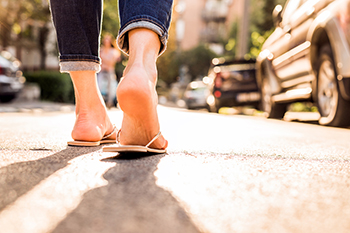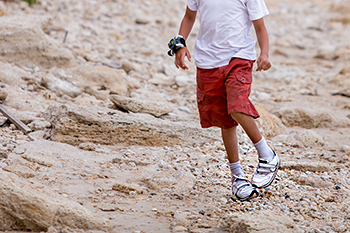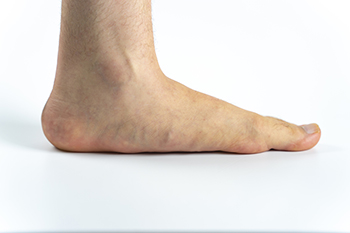Blog
Fungal and Bacterial Infections From Wearing Flip-Flops

Wearing flip-flops leaves your feet vulnerable to various infections, from bacteria to viruses. When your feet are exposed in public places, harmful organisms, such as staphylococcus, can cling to them. This bacterium can cause skin irritation, and in extreme cases, serious foot conditions may emerge. The risk increases if you have open sores or even small wounds from recent pedicures. Another concern is athlete's foot, which is a contagious fungal infection that causes itching. Walking with minimal footwear increases the chances of encountering and contracting this fungus. You also risk exposure to the virus responsible for warts, which is HPV, while wearing flip-flops. If you enjoy wearing flip-flops, it is suggested that you make an appointment with a podiatrist to discuss similarly easy and comfortable footwear alternatives that are healthier for your feet.
Flip-flops can cause a lot of problems for your feet. If you have any concerns about your feet or ankles, contact one of our podiatrists from Pennsylvania. Our doctors will assist you with all of your foot and ankle needs.
Flip-Flops and Feet
Flip-flops have managed to become a summer essential for a lot of people. While the shoes may be stylish and easy to slip on and off, they can be dangerous to those who wear them too often. These shoes might protect you from fungal infections such as athlete’s foot, but they can also give you foot pain and sprained ankles if you trip while wearing them.
When Are They Okay to Wear?
Flip-flops should only be worn for very short periods of time. They can help protect your feet in places that are crawling with fungi, such as gym locker rooms. Athlete’s foot and plantar warts are two common fungi that flip-flops may help protect your feet against.
Why Are They Bad for My Feet?
These shoes do not offer any arch support, so they are not ideal for everyday use. They also do not provide shock absorption or heel cushioning which can be problematic for your feet. Additionally, you may suffer from glass cuts, puncture wounds, and stubbed toes since they offer little protection for your feet.
More Reasons Why They Are Bad for Your Feet
- They Slow You Down
- May Cause Blisters and Calluses
- Expose Your Feet to Bacteria
If you have any questions, please feel free to contact one of our offices located in Plymouth Meeting and Ambler, PA . We offer the newest diagnostic and treatment technologies for all your foot care needs.
An Overview of Clubfoot

Clubfoot is a congenital condition that affects infants' feet, making them appear rotated inward and downward. While it may sound intimidating, clubfoot is both a common and treatable condition. It occurs during fetal development when the tendons and ligaments in the foot are shorter than usual, pulling the foot into an abnormal position. In some cases, both feet may be affected. Clubfoot is not painful for the infant, but if left untreated, it can lead to severe mobility issues as they grow. The good news is that with early intervention, clubfoot can be effectively corrected. The Ponseti method, a non-surgical approach, is often employed. It involves gentle manipulation of the foot and the use of a series of casts to gradually move the foot into the correct position. Afterward, a brace is used to maintain the corrected position. In some cases, a minor surgical procedure may be necessary. Early detection and treatment are essential for the best outcome, and with the right care, many children with clubfoot can grow up to lead active, pain-free lives. If your child has been born with clubfoot, it is suggested that you speak with a podiatrist as quickly as possible who can begin the correct treatment method.
Congenital foot problems require immediate attention to avoid future complications. If you have any concerns, contact one of our podiatrists of Pennsylvania. Our doctors can provide the care you need to keep you pain-free and on your feet.
Congenital foot problems are deformities affecting the feet, toes, and/or ankles that children are born with. Some of these conditions have a genetic cause while others just happen. Some specific foot ailments that children may be born with include clubfeet, polydactyly/macrodactyly, and cleft foot. There are several other foot anomalies that can occur congenitally. What all of these conditions have in common is that a child may experience difficulty walking or performing everyday activities, as well as trouble finding footwear that fits their foot deformity. Some of these conditions are more serious than others. Consulting with a podiatrist as early as possible will help in properly diagnosing a child’s foot condition while getting the necessary treatment underway.
What are Causes of Congenital Foot Problem?
A congenital foot problem is one that happens to a child at birth. These conditions can be caused by a genetic predisposition, developmental or positional abnormalities during gestation, or with no known cause.
What are Symptoms of Congenital Foot Problems?
Symptoms vary by the congenital condition. Symptoms may consist of the following:
- Clubfoot, where tendons are shortened, bones are shaped differently, and the Achilles tendon is tight, causing the foot to point in and down. It is also possible for the soles of the feet to face each other.
- Polydactyly, which usually consists of a nubbin or small lump of tissue without a bone, a toe that is partially formed but has no joints, or an extra toe.
- Vertical talus, where the talus bone forms in the wrong position causing other bones in the foot to line up improperly, the front of the foot to point up, and the bottom of the foot to stiffen, with no arch, and to curve out.
- Tarsal coalition, when there is an abnormal connection of two or more bones in the foot leading to severe, rigid flatfoot.
- Cleft foot, where there are missing toes, a V-shaped cleft, and other anatomical differences.
- Macrodactyly, when the toes are abnormally large due to overgrowth of the underlying bone or soft tissue.
Treatment and Prevention
While there is nothing one can do to prevent congenital foot problems, raising awareness and receiving neonatal screenings are important. Early detection by taking your child to a podiatrist leads to the best outcome possible.
If you have any questions please feel free to contact one of our offices located in Plymouth Meeting and Ambler, PA . We offer the newest diagnostic tools and technology to treat your foot and ankle needs.
Causes, Symptoms, and Treatment of Flat Feet

Flat feet, medically known as pes planus, is a common condition where the arch of the foot is abnormally low or nonexistent, causing the entire sole to touch the ground when standing. This can be due to various factors, such as genetics, obesity, pregnancy, or repetitive high-impact activities. While some people with flat feet experience no discomfort, others may develop symptoms that affect their daily lives. Flat feet can originate in childhood, where the arch has not yet developed, and may persist into adulthood. Over time, the wear and tear on the posterior tibial tendon can lead to the arch collapsing, resulting in overpronation. Ankles and knees can also be affected, as flat feet may cause the ankles to turn inward, leading to alignment issues in the legs. Symptoms can range from difficulty standing on tiptoe to knee and back pain, arch strain, and swelling along the inside of the ankle. When it comes to treatment, a range of options can help alleviate the discomfort associated with flat feet. Special shoes with strong heel counters, steel or carbon fiber shanks, and medial postings can assist in alignment. Custom-designed arch supports, molded to your foot's unique contours, are often recommended. Stretching exercises for a shortened Achilles tendon may also prove beneficial. For help in dealing with flat feet, it is suggested that you make an appointment with a podiatrist to determine the best course of action for your specific needs.
Flatfoot is a condition many people suffer from. If you have flat feet, contact one of our podiatrists from Pennsylvania. Our doctors will treat your foot and ankle needs.
What Are Flat Feet?
Flatfoot is a condition in which the arch of the foot is depressed and the sole of the foot is almost completely in contact with the ground. About 20-30% of the population generally has flat feet because their arches never formed during growth.
Conditions & Problems:
Having flat feet makes it difficult to run or walk because of the stress placed on the ankles.
Alignment – The general alignment of your legs can be disrupted, because the ankles move inward which can cause major discomfort.
Knees – If you have complications with your knees, flat feet can be a contributor to arthritis in that area.
Symptoms
- Pain around the heel or arch area
- Trouble standing on the tip toe
- Swelling around the inside of the ankle
- Flat look to one or both feet
- Having your shoes feel uneven when worn
Treatment
If you are experiencing pain and stress on the foot you may weaken the posterior tibial tendon, which runs around the inside of the ankle.
If you have any questions please feel free to contact one of our offices located in Plymouth Meeting and Ambler, PA . We offer the newest diagnostic and treatment technologies for all your foot and ankle needs.

